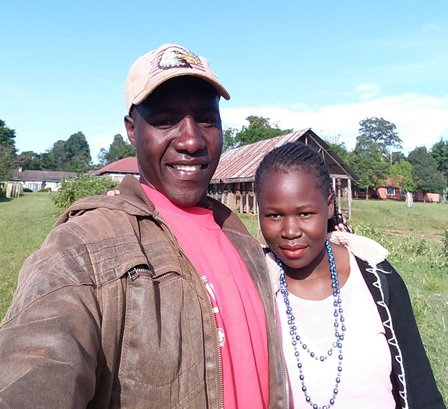Using GB and Plant Extracts
to Protect Crops Naturally
By Fredrick Onyango, Director, SADA
We received the following innovative report on natural nutrient balance and pest control through the use of plant extracts from Sustainable Agroecological Development Action (SADA, sadacentrekenya.net), a GROW BIOINTENSIVE Demonstration/Education and Research organization located in Siaya County, Kenya.
SADA Director Fredrick Onyango (2019 TJC intern, pictured below with wife Hellen) says: "Food security begins with sustainability of soil fertility. We established SADA Centre to restore the hope of farmers that despite the extent of soil degradation we can get our soil fertility back. The SADA staff trains farmers on compost making, management, and cured compost application. Some other major components are soil moisture conservation, crop diversity and rotation, cover cropping, minimal tillage (double digging), and use of open pollinated seeds."

Use GROW BIOINTENSIVE farming methods to feed and protect crops! In Kenya, after planting, the period between September and October is very critical since the crops are in their growth stage. They need weeding, enough nutrients, disease and pest control. During this time agro-veterinary shops make good sales from selling chemicals to farmers. Top dressing, and pest and disease control cost a lot of money. Chemical fertilizers commonly used by farmers are primarily made from non-renewable sources, including fossil fuels. Once these sources are depleted it is difficult to regenerate them.
The problem with chemical fertilizers
It has been scientifically proven that excessive use of fertilizers damages the soil and causes other negative environmental effects [see this article from The Guardian on how pesticides damage vital soil organisms]. This soil damage is one of the reasons why farmers in the breadbasket areas of Kenya like Trans Nzoia County no longer enjoy the bountiful harvest of maize crop.
Use plant extracts instead
The yellow and purplish color of the maize, beans and other crops usually shows that the crops do not have enough Nitrogen (N), Phosphorus (P) and Potassium (K) and therefore require a supply of these nutrients. Well prepared plant extracts can address these deficiencies if nutrient rich plants such as Tithonia (Mexican sunflower, Tithonia rotundifolia), stinging nettle (Urtica dioica) and comfrey (Symphytum), complemented with bio slurry, are applied to growing crops in the right way. These correct the deficiencies and even make the crop stronger to withstand pests and diseases. When prepared with plants that have insecticidal and antifungal properties such as the African marigold (Tagetes erecta), chilies, garlic, sodom’s apple (Solanum incanum) and pyrethrum (Chrysanthemum cinerariifolium), the farmer can easily control harmful crop pests and diseases. Using these organic inputs, the farmers not only reduce the cost of buying chemicals, but also ensure they have food crops that are safe from chemical residues. Organics work differently: farmers should remember that plant extracts do not work in the same way as purchased chemicals. For instance, organic fertilizers like farmyard manure break down according to nature’s rules. This means that they may not release nutrients as quickly as you expect. Organic plant extracts should be applied two to three times a week for them to protect your crops against harmful pests. There’s little to no risk of toxic build up of chemicals and salts that can be deadly to plants and other organisms that consume them. Organic fertilizers are renewable, biodegradable, environmentally friendly and therefore sustainable.
♥
top | Newsletter Home |Table of Contents| Archive

|



